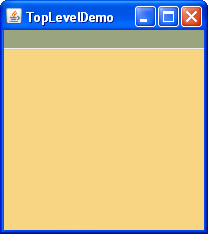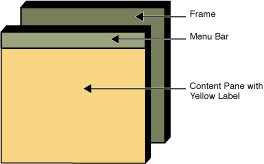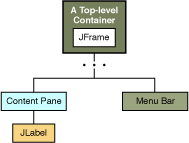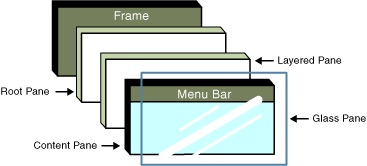Using Top-Level Containers
JFrame,
JDialog, and
JApplet.
When using these classes,
you should keep these facts in mind:
- To appear onscreen,
every GUI component must be part of
a containment hierarchy.
A containment hierarchy is a tree of components
that has a top-level container as its root.
We'll show you one in a bit.
- Each GUI component can be contained only once.
If a component is already in a container
and you try to add it to another container,
the component will be removed from the first container
and then added to the second.
- Each top-level container has a
content pane that, generally speaking, contains
(directly or indirectly)
the visible components in that top-level container's GUI.
- You can optionally add a menu bar to a top-level container. The menu bar is by convention positioned within the top-level container, but outside the content pane. Some look and feels, such as the Mac OS look and feel, give you the option of placing the menu bar in another place more appropriate for the look and feel, such as at the top of the screen.
 |
 |
You can find the entire source for this example in
TopLevelDemo.java.
Although the example uses a JFrame in
a standalone application, the same concepts apply
to JApplets and JDialogs.
Here's the containment hierarchy for this example's GUI:

As the ellipses imply, we left some details out of this diagram. We reveal the missing details a bit later. Here are the topics this section discusses:
- Top-Level Containers and Containment Hierarchies
- Adding Components to the Content Pane
- Adding a Menu Bar
- The Root Pane (a.k.a. The Missing Details)
Top-Level Containers and Containment Hierarchies
Each program that uses Swing components has at least one top-level container. This top-level container is the root of a containment hierarchy — the hierarchy that contains all of the Swing components that appear inside the top-level container.
As a rule, a standalone application with a Swing-based GUI
has at least one containment
hierarchy with a JFrame as its root.
For example, if an application has one main window and two dialogs,
then the application has three containment hierarchies,
and thus three top-level containers.
One containment hierarchy has a JFrame
as its root,
and each of the other two has a JDialog object
as its root.
A Swing-based applet has at least one containment hierarchy,
exactly one of which is rooted by a JApplet object.
For example, an applet that brings up a dialog
has two containment hierarchies.
The components in the browser window
are in a containment hierarchy
rooted by
a JApplet object.
The dialog has a containment hierarchy
rooted by a JDialog object.
Adding Components to the Content Pane
Here's the code that the preceding example
uses to get a frame's content pane and add the yellow
label to it:
frame.getContentPane().add(yellowLabel, BorderLayout.CENTER);
getContentPane method.
The default content pane is
a simple intermediate container
that inherits from JComponent,
and that uses a BorderLayout
as its layout manager.
It's easy to customize the content pane —
setting the layout manager
or adding a border, for example.
However, there is one tiny gotcha.
The getContentPane method
returns a Container object,
not a JComponent object.
This means that if you want
to take advantage of the content pane's JComponent features,
you need to either typecast the return value
or create your own component to be the content pane.
Our examples generally take the second approach,
since it's a little cleaner.
Another approach
we sometimes take is to simply add a customized component
to the content pane,
covering the content pane completely.
Note that the default layout manager for JPanel
is FlowLayout;
you'll probably want to change it.
To make a component the content pane,
use the top-level container's
setContentPane method.
For example:
//Create a panel and add components to it. JPanel contentPane = new JPanel(new BorderLayout()); contentPane.setBorder(someBorder); contentPane.add(someComponent, BorderLayout.CENTER); contentPane.add(anotherComponent, BorderLayout.PAGE_END); topLevelContainer.setContentPane(contentPane);
Note: As a convenience, the
add method and its variants,
remove and setLayout have been overridden
to forward to the contentPane as necessary.
This means you can write
frame.add(child);
contentPane. Note that only these three methods do this. This means that
getLayout() will not return the layout set with
setLayout().
Adding a Menu Bar
In theory, all top-level containers can hold a menu bar. In practice, however, menu bars usually appear only in frames and applets. To add a menu bar to a top-level container, create aJMenuBar object,
populate it with menus,
and then call setJMenuBar.
The TopLevelDemo adds a menu bar
to its frame with this code:
frame.setJMenuBar(greenMenuBar);
The Root Pane
Each top-level container relies on a reclusive intermediate container called the root pane. The root pane manages the content pane and the menu bar, along with a couple of other containers. You generally don't need to know about root panes to use Swing components. However, if you ever need to intercept mouse clicks or paint over multiple components, you should get acquainted with root panes.Here's a list of the components that a root pane provides to a frame (and to every other top-level container):

For more details, see How to Use Root Panes.
